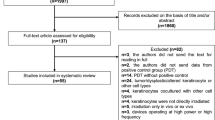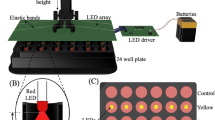Abstract
The systemic mechanisms of the wound healing effect of low intensity lasers remain largely uninvestigated. The goal of this randomized, placebo controlled, double blind study is to prove that irradiation of a small area of the human body with visible and infrared polarized (VIP) light (400–3400 nm, 95% polarization, 40 mW cm2, 12 J cm2) leads to an increase of the growth promoting (GP) activity of the entire circulating blood for primary cultures of human keratinocytes (KCs).
Thirty minutes after the VIP-irradiation of a sacral area of volunteers, the GP activity of circulating blood was seen to increase through the elevation of the number of KCs cultured with the isolated plasma by 20 ± 3%, p < 0.001. A similar increase in GP activity was seen in plasma derived from the in vitro irradiated blood of each volunteer, and from the mixture of irradiated and non-irradiated autologous blood (1 : 10). Enhanced GP activity was also recorded at 24 h after the 1st and 4–9th daily phototherapeutic sessions. Hence, exposure of volunteers to VIP light leads to a fast increase in the GP activity of the entire circulating blood for human KCs in vitro, which is a consequence of the transcutaneous photomodification of blood and its effect on the rest of the circulating blood volume.
Similar content being viewed by others
References
B. Braverman, R. J. McCarthy, A. D. Ivankovich, D. E. Forde, M. Overfield and M. Bapna, Effect of helium-neon and infrared laser irradiation on wound healing in rabbits, Lasers Surg. Med., 1989, 9, 50–58.
S. Rochkind, M. Rousso, M. Nissan, M. Villarreal, L. Barr-Nea and D. G. Rees, Systemic effects of low power laser irradiation on the peripheral and central nervous system, cutaneous wounds and burns, Lasers Surg. Med., 1989, 9, 174–182.
A. Mester, E. Mester and A. Mester, Open wound healing - bedsores, ulcus cruris, burns - with systemic effects of LLLT, in Lasers in medicine and dentistry, ed. Z. Simunovic, Vitagraf, Rijeka, 2000, pp. 227–244.
Low level laser therapy. Clinical practice and scientific background, ed. J. Tuner and L. Hode, Prima Books, Grängsberg, 2002, pp. 76–175, 287–312.
A. Schindl, G. Heinze, M. Schindl, H. Pernerstorfer-Schon and L. Schindl, Systemic effects of low intensity laser irradiation on skin microcirculation in patients with diabetic microangiopathy, Microvasc. Res., 2002, 64, 240–246.
B. S. Briskin, I. M. Aliev, A. K. Polonski, N. N. Khachatarian and I. V. Stupin, Immunomodulation by laser irradiation in immunodeficiency, Laser Ther., 1996, 8, 67–68.
S. G. Onuchin, Y. V. Benenson, S. G. Belousov, Y. L. Onuchina, Y. D. Utyomova, S. M. Zyazina and N. Y. Mironycheva, Immunological efficacy of low energy helium-neon laser therapy in patients with diabetes mellitus, Laser Ther., 1996, 8, 73–74.
M. I. Kovalyov, Dynamics of prolactin, gonadotrophin, and sexual steroids in the parturient’s blood serum during laser therapy, Laser Med., 2000, 4, 40–42.
P. Van der Veen and P. Lievens, Low level laser therapy (LLLT): the influence on the proliferation of fibroblasts and the influence on the regeneration process of lymphatic, muscular and cartilage tissue, in Lasers in medicine and dentistry, ed. Z. Simunovic, Vitagraf, Rijeka, 2000, pp. 187–215.
K. A. Samoilova, K. D. Obolenskaya, A. V. Vologdina, S. A. Snopov and E. V. Shevchenko, Single skin exposure to visible polarized light induces rapid modification of entire circulating blood. 1. Improvement of rheologic and immune parameters, Proc. SPIE, 1998, 3569, 90–103.
J. F. Ennever, Phototherapy for neonatal jaundice, J. Photochem. Photobiol., 1988, 47, 871–876.
G. Frick, Fibel der Ultraviolett Bestrahlung des Blutes, Hans Müller-Verlag, München, 1993, pp. 48–63.
V. I. Karandashov and E. V. Petukhov, in Ultraviolet irradiation of blood, Meditsina, Moscow, 1997, pp. 34–186.
M. Fenyo, Theoretical and experimental basis of biostimulation, Optics Laser Technol., 1984, 16, 209–215.
T. I. Karu, Photobiological fundamentals of low power laser, J. Quantum Electron., 1987, 23, 1703–1717.
T. Kubasova, M. Horvath, K. Kocsis and M. Fenyo, Effect of visible light on some cellular and immune parameters, Immunol. Cell Biol., 1995, 73, 239–244.
P. Bolton, M. Dyson and S. Young, The effect of polarized light on the release of growth factors from the U-937 macrophage-like cell line, Laser Ther., 1992, 4, 33–37.
K. A. Flemming, N. A. Cullum and E. A. Nelson, A systemic review of laser therapy for venous leg ulcers, J. Wound Care, 1999, 8, 111–114.
L. Medenica and M. Lens, The use of polarised polychromatic non-coherent light alone as a therapy for venous leg ulceration, J. Wound Care, 2003, 12, 37–40.
J. G. Rheinwald and H. Green, Serial cultivation of a strain of human epidermal keratinocytes: the formation of keratinizing colonies from single cells, Cell, 1975, 6, 331–334.
N. M. Yudintzeva, J. V. Gorelic, I. A. Diakonov, N. V. Kalmykova, M. I. Blinova, G. P. Pinaev and B. A. Paramonov, Transplantation of allogen keratinocyte sheets on burns, Tsitologiia, 1999, 41, 328.
T. Mosman, Rapid colorimetric assay for cellular growth and survival: application to proliferation and cytotoxicity assays, J. Immunol. Methods, 1983, 65, 55–63.
W. Kueng, E. Silber and U. Eppenberger, Quantification of cells cultured on 96-well plates, Anal. Biochem., 1989, 182, 16–29.
K. A. Samoilova, A. Yu. Zaritskii, E. R. Stankevich and A. P. Mironova, Effect of UV-irradiated donor blood on the colony-forming ability of human bone marrow cells in culture, Tsitologiia, 1985, 27, 488–492.
I. I. Firulina, K. A. Samoilova and N. K. Belisheva, Enhancement of the growth promoting properties of UV-irradiated blood. I Dependence on the irradiation dose, initial cell growth promoting potention of blood, and functional state of target cells, Tsitologiia, 1987, 7, 818–824.
A. P. Savage, V. K. Chatterjee, H. Gregory and S. R. Bloom, Epidermal growth factor in blood, Regul. Pept., 1986, 30, 199–206.
J. Kiaru, L. Viinikka, G. Myllyla, K. Pesonen and J. Perheentupa, Cytoskeleton-dependent release of human platelet epidermal growth factor, Life Sci., 1991, 49, 1997–2003.
I. A. Utz, S. R. Utz and V. V. Tuchin, Effects of low energy laser biostimulation on rheological properties of blood, Proc. SPIE, 1992, 1983, 83–90.
A. G. Brill, G. E. Brill and V. F. Kirichuk, Effect of He-Ne irradiation on platelet activation and aggregation, Bull. Exp. Biol. Med., 1999, 7, 48–50.
M. Olban, B. Wachowicz, M. Koter and M. Bryszewska, The biostimulatory effect of red laser irradiation on pig blood platelet function, Cell Biol. Int., 1998, 22, 245–248.
P. G. W. Gettins and B. C. Crews, Epidermal growth factor binding to human α2-Macroglobulin. Implications for α2-Macroglobulin-growth factor interactions, Biochemistry, 1993, 32, 7916–7921.
C. T. Chu and S. V. Pizzo, α2-Macroglobulin, complement and biologic defense: antigens, growth factors, microbial proteases, and receptor legation, Lab. Invest., 1994, 71, 792–812.
J. C. Bonner, M. Hoffman and A. R. Brody, Alpha-2-macroglobulin secreted by alveolar macrophages serves as a binding protein for a macrophage-derived homologue of platelet-derived growth factor, Am. J. Resp. Cell Mol. Biol., 1989, 1, 171–179.
S. S. Huang, P. O’Crady and J. S. Huang, Human transforming growth factor beta. alpha-2-macroglobulin complex is a latent form of transforming growth factor beta, J. Biol. Chem., 1988, 25, 1535–1541.
W. Borth, R. Feinman, S. Gonias, J. Quigly and D. Strickland, Biology of α2-macroglobulin, its receptor and related proteins, Ann. N. Y. Acad. Sci., 1994, 737, 1–521.
S. M. Wu, D. D. Patel and S. V. Pizzo, Oxidized α2-macroglobulin (α2M) differentially regulate receptor binding by cytokines/growth factors: implications for tissue injury and repair mechanisms in inflammation, J. Immunol., 1998, 15, 4356–4365.
N. Grossman, N. Schneid, H. Reuveni, S. Halevy and R. Lubart, 780 nm low power diode laser irradiation stimulates proliferation of keratinocyte cultures: involvement of reactive oxygen species, Lasers Surg. Med., 1998, 22, 212–218.
R. Lubart, H. Friedmann, R. Lavie, N. Grossmann, M. Sinyakov and S. Belotsky, Effect of visible light on reactive oxygen species production, Laser Technol., 2000, 10, 7–11.
A. Grőne, Keratinocytes and cytokines, Vet. Immunol. Immunopathol., 2002, 88, 1–12.
J. Massague and A. Pandiella, Membrane-anchored growth factors, Annu. Rev. Biochem., 1993, 62, 515–541.
S. Tokumaru, S. Higashiyama, T. Endo, T. Nakagawa, J. I. Miyagawa, K. Yamamori, Y. Hanakawa, H. Ohmoto, K. Yoshino, Y. Shirakata, Y. Matsuzawa, K. Hashimoto and N. Taniguchi, Ectodomain shedding of epidermal growth factor receptor ligands is required for keratinocyte migration in cutaneous wound healing, J. Cell Biol., 2000, 16, 209–220.
H. S. Yu, K. L. Chang, C. L. Yu, J. W. Chen and G. S. Chen, Low-energy helium-neon laser irradiation stimulates interleukin-1 alpha and interleukin-8 release from cultured human keratinocytes, J. Invest. Dermatol., 1996, 107, 593–596.
N. Maas-Szabowski, H. Stark and N. E. Fusenig, Keratinocyte growth regulation in defined organotypic cultures through IL-1-induced keratinocyte growth factor expression in resting fibroblasts, J. Invest. Dermatol., 2000, 114, 1075–1084.
I. A. Gamaley and I. V. Klyubin, Roles of reactive oxygen species: signaling and regulating of cellular functions, Int. Rev. Cytol., 1999, 188, 203–255.
H. Sauer, M. Wartenberg and J. Hescheler, Reactive oxygen species as intracellular messengers during cell growth and differentiation, Cell Physiol. Biochem., 2001, 11, 173–186.
M. Reth, Hydrogen peroxide as second messenger in lymphocyte activation, Nat. Immunol., 2002, 3, 1129–1134.
Author information
Authors and Affiliations
Corresponding author
Rights and permissions
About this article
Cite this article
Samoilova, K.A., Bogacheva, O.N., Obolenskaya, K.D. et al. Enhancement of the blood growth promoting activity after exposure of volunteers to visible and infrared polarized light. Part I: stimulation of human keratinocyte proliferation in vitro. Photochem Photobiol Sci 3, 96–101 (2004). https://doi.org/10.1039/b305738k
Received:
Accepted:
Published:
Issue Date:
DOI: https://doi.org/10.1039/b305738k




